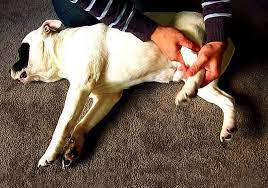As pet owners, we strive to give our animals the finest care possible. However, when our pets exhibit symptoms such as shaking and vomiting, it can be upsetting. These symptoms can signal several underlying problems, ranging from simple digestive disorders to more significant health issues. In this detailed guide, we’ll look at the causes of dog shaking and vomiting, as well as treatment alternatives and when you should seek veterinarian advice. Let’s solve the mysteries underlying these symptoms and protect our four-legged pets’ health.
Common Causes of Dog Shaking and Vomiting
Understanding the possible reasons for dog shaking and vomiting is essential for deciding the best course of treatment.
There are several typical reasons for your dog shaking and vomiting. One probable cause is dietary indiscretion, which occurs when your dog consumes anything inappropriate, such as spoiled food, garbage, or toxic chemicals. This might cause gastrointestinal discomfort, resulting in symptoms such as shaking and vomiting. Another possibility is motion sickness, particularly if your dog becomes worried or uncomfortable during car rides. Stress and anxiety can also cause similar symptoms in dogs since they affect their digestive system directly.
Furthermore, viral or bacterial diseases, such as parvovirus or gastroenteritis, can cause shaking and vomiting in your dog. Other symptoms like diarrhea, a lack of appetite, and fatigue are frequently present with these infections. Furthermore, many medications, such as antibiotics, may cause gastrointestinal side effects, which result in these symptoms. It is crucial to note that shaking and vomiting in a dog can sometimes be symptoms of more serious underlying diseases such as kidney disease, liver problems, or pancreatitis. The identification of the underlying cause is critical for appropriate therapy and management.
Diagnostic Steps and When to Seek Veterinary Attention
If your dog is shaking and vomiting, it’s critical to understand when self-care is suitable and when veterinarian intervention is required.
You might try a few home remedies to relieve minor shaking and vomiting in your dog who is otherwise awake, active, and eating well. Start by temporarily withholding food for 12 to 24 hours to allow the gastrointestinal tract to settle. To prevent dehydration, give modest amounts of water and gradually reintroduce a bland meal of boiled chicken and rice. Monitor your dog closely and ensure they are not worsening.
If your dog’s shaking and vomiting continue or increase, it’s necessary to seek veterinarian care. Additionally, if your dog exhibits additional troubling symptoms such as lethargy, pale gums, blood in vomit or stool, gastrointestinal pain, or behavioral abnormalities, you must visit a veterinarian as soon as possible. When in doubt, it’s always best to err on the side of caution and have a professional assess your dog’s condition. A veterinarian will examine the animal thoroughly, run diagnostic tests, and provide medication based on the underlying cause.
Treatment Options for Dog Shaking and Vomiting
The underlying cause and severity of the symptoms will determine the dog shaking and vomiting treatment plan.
The primary goal in situations of moderate gastrointestinal disturbance is to rest the digestive system and provide supportive care. To relieve nausea and vomiting, your veterinarian may offer a bland diet, probiotics, and drugs. If stress or anxiety is contributing to the symptoms, anti-anxiety drugs can be provided. It is critical to strictly adhere to your veterinarian’s treatment plan and any food restrictions.
Targeted therapy is required for more severe situations, such as infections or underlying health issues. Antibiotics or antiviral medications may be used to battle the infection, fluid therapy to correct dehydration, and other supportive care to address the individual disease. Each case is different, and your veterinarian will personalize the treatment plan to meet your dog’s specific needs.
When to Worry: Red Flags to Watch For
While some cases of shaking and vomiting in your dog can be treated at home, certain red flags require emergency veterinary intervention.
It is crucial to seek veterinary help if your dog experiences severe symptoms after shaking and vomiting or if they continue despite home care. Prolonged or bloody vomiting, severe stomach discomfort or distension, pale gums, weakness or collapse, difficulty breathing, or changes in mental alertness are all red signals to look out for. These symptoms may suggest a more serious disease that necessitates immediate medical attention.
Furthermore, if your dog has consumed a hazardous substance, such as certain plants, human medications, or household chemicals, you should immediately contact your veterinarian or a pet poison helpline. In such cases, time is important, and professional assistance can help limit any injury.
Preventive Measures to Minimize Dog Shaking and Vomiting
Preventing dog shaking and vomiting can help promote overall health.
Maintaining nutritious and balanced food for your dog is critical for avoiding dietary indiscretions and associated digestive disorders. Make sure your dog’s food is of high quality and appropriate for their age, breed, and nutritional needs. Feeding them table scraps or foods known to be poisonous to dogs, such as chocolate, grapes, onions, and certain artificial sweeteners, is not recommended.
Reducing stress and anxiety can also assist in reducing shaking and vomiting. Provide a quiet and secure environment for your dog, and address any stress or anxiety triggers. Regular exercise, mental stimulation, and positive reinforcement training can all help your dog’s emotional health.
Dietary Management for Dogs Prone to Shaking and Vomiting
If your dog is prone to recurring bouts of shaking and vomiting, dietary change can help prevent future incidents.
Consult your doctor to see if your dog’s condition necessitates a particular diet. To lessen the risk of gastrointestinal discomfort, a hypoallergenic or easily digestible diet may be recommended in some circumstances. These diets are designed to be mild on the digestive system and can aid in the relief of symptoms related to food sensitivities or allergies.
Additionally, serving smaller, more frequent meals throughout the day can be advantageous. This method relieves digestive strain and lessens the chance of overeating or quick meal consumption, both of which can contribute to shaking and vomiting.
Managing Motion Sickness in Dogs
Motion sickness is a major cause of shaking and vomiting in dogs, but there are preventative measures you may take.
There are a few things you can try if your dog gets motion sickness while driving. Starting with short trips and progressively increasing the duration over time can result in eventual desensitization to car travel. Keep the car well-ventilated, and don’t feed your dog right before a car ride. There are also over-the-counter medications and natural therapies available to help dogs with motion sickness. Consult your veterinarian for specific suggestions.
Using rewards and praise to create a pleasant association with car rides can also help reduce anxiety and the chance of motion sickness. Make your dog’s travel experience more comfortable and fun by offering familiar bedding or toys.
The Importance of Regular Veterinary Check-ups
Regular veterinary check-ups are essential for maintaining your dog’s overall health and catching any underlying issues early on.
Even if your dog isn’t currently shaking and vomiting, regular veterinary checkups are critical for avoiding and diagnosing any health issues. Your veterinarian can perform a comprehensive examination, assess your dog’s overall health, and give preventive care such as immunizations and parasite prevention. Regular check-ups enable prompt intervention and treatment if any problems occur.
During these visits, make sure to express any concerns you have about your dog’s history of shaking and vomiting. If necessary, your veterinarian can provide additional advice on preventive measures, dietary changes, and more diagnostic testing. Maintaining your dog’s health and well-being requires open communication with your veterinarian.
Natural Remedies That Can Help Alleviate Dog Shaking and Vomiting
If your dog is shaking and vomiting, you may want to look into natural therapies that might bring relief and promote their well-being.
Natural remedies can be an excellent addition to your dog’s treatment strategy, providing gentle and holistic methods for symptom relief and overall wellness. While natural remedies might be beneficial, they should not be used in place of professional veterinarian care. Before introducing any new medicines or treatments, always consult with your veterinarian.
Let’s have a look at some natural remedies for dog shaking and vomiting. These therapies can provide temporary comfort in mild situations or supplement veterinarian care in more severe cases. Remember that each dog is unique, therefore, it’s critical to study their reactions and seek personalized guidance from your veterinarian.
#1. Ginger
Ginger is a well-known natural remedy that can help dogs suffering from nausea and intestinal discomfort. Also, Ginger has long been used to relieve stomach upset in people, and it may also have comparable advantages for our canine companions. Its anti-inflammatory characteristics can help reduce gastrointestinal irritation and its natural ingredients aid in stomach relaxation and nausea relief. Ginger might be very beneficial for dogs suffering from motion sickness.
Grate fresh ginger root and mix a tiny quantity (about ¼ teaspoon for small dogs and ½ teaspoon for larger dogs) with their food to give to your dog. Alternatively, you can locate ginger supplements or treats designed expressly for dogs at pet stores, or visit your veterinarian for dose recommendations.
#2. Slippery Elm
Slippery elm is another natural medicine that might help dogs suffering from stomach issues. Also, Slippery elm is derived from the inner bark of the slippery elm tree and has been used to treat gastrointestinal disorders for millennia. It provides a protective layer along the digestive tract, which reduces inflammation and discomfort. Slippery elm can help dogs with diseases including gastritis, colitis, or acid reflux, all of which can cause shaking and vomiting.
Slippery elm powder can be found in health food stores or specialty pet stores. Mix a little amount (depending on your dog’s weight) with water or a bland diet, such as cooked chicken and rice, and give it to your dog. Consult your veterinarian as always to determine the proper dosage and duration of use.
#3. Peppermint
Peppermint is a refreshing herb that can aid in soothing a dog’s upset stomach and reducing nausea.
Menthol, found in peppermint, has antispasmodic effects that can help calm the muscles of the gastrointestinal tract. This is very useful for dogs that have stomach cramps or spasms that cause shaking and vomiting. Peppermint also has a cooling impact, making it feel refreshing.
It’s crucial to note that, while peppermint can help with symptoms, dogs should never be given pure essential oils. Look for peppermint-infused goods designed exclusively for dogs, such as natural treats or herbal pills. These items are usually safe and can produce the required results.
What does it mean when my dog is shaking and throwing up?
Smaller dog breeds and puppies are more likely to vomit and shake in response to anxiety, fear, or excitement. A toy Poodle, for example, who is sensitive to the sounds of fireworks, skateboards, and other loud noises may react by vomiting and shaking. Your dog may vomit and shake as a result of a glucose imbalance.
Should I be worried if my dog is shaking and vomiting?
Shivering and trembling could be signs of something more serious, such as poisoning, kidney failure, or injury. So, if your dog suddenly begins trembling or shivering, look for other symptoms such as diarrhea, vomiting, or limping. Then contact your veterinarian right away.
What do you do when your dog is shaking and sick?
If your dog starts shaking abnormally, develops other symptoms of disease, or you fear they have consumed a toxin, you should seek urgent veterinary care from your main veterinarian or a local emergency veterinary facility.
Can an upset stomach in dogs cause shaking?
A stomach ache or upset stomach could be the cause of your dog’s trembling. Just make sure to talk to their vet about what they’ve lately consumed.
How do I know if my dog is poisoned?
Clinical indications of dog poisoning may include Vomiting, diarrhea, excessive salivation, loss of appetite, nausea, or dry heaving, among other gastrointestinal symptoms. Pale gums, a racing heart, coughing up or vomiting blood, weakness or lethargy, or a dog falling over or collapsing are all signs of internal bleeding.
What do I give my dog for vomiting?
If it’s a one-time occurrence and your pet otherwise behaves properly, Sheen advocates withholding meals for around 12 hours to give their stomach some rest. After that, you can feed your dog cooked chicken and white rice for the next 24 to 48 hours to see if the vomiting stops.
Conclusion
Dog shaking and vomiting can be upsetting symptoms for pet owners, but they can have a variety of causes. Understanding the underlying causes of these symptoms is critical in deciding the best treatment and when to seek veterinarian care. While some cases can be managed at home with supportive care, it is crucial to recognize the red flags that require immediate professional evaluation.
You can reduce the occurrence of shaking and vomiting in your dog by taking preventive steps, addressing nutritional management, and controlling motion sickness. Regular veterinary check-ups allow you to discuss any concerns and guarantee your dog’s overall health. Remember that your veterinarian is your best resource for navigating these circumstances and giving tailored advice for your pet.
Related Articles
- DOG MAMMARY TUMOR REMOVAL COST
- HOW LONG CAN A DOG GO WITHOUT EATING OR DRINKING?
- COUGH MEDICINE FOR DOGS: Best Natural Remedies
- FLEA, TICK, AND HEARTWORM PREVENTION
- Grieving The Loss Of A Pet After Euthanasia: How To Cope
- Is Hydrocortisone Safe For Dogs? Everything You Should Know






